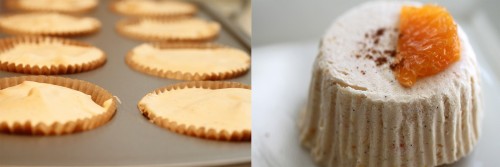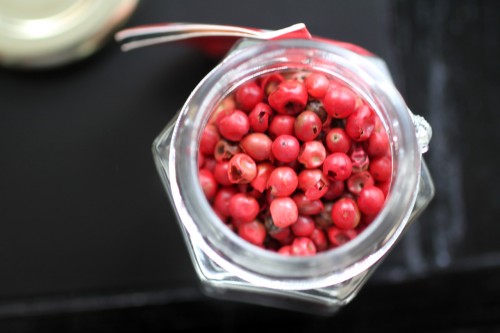“Morir Soñando” Semifreddo
Food phases. I don’t know if any of you have them, but I go through periods of craving where I want the same thing over and over again. In college, I had this extended phase with Dominican food. For dinner, I would trek out to an area of town where there was a big Latin American community. The Dominican spots were amazing! And for like $5, you would get a heaping plate of stewed chicken, saffron rice and fried plaintains with garlic. I was a bit obsessed (and had the resulting 15 lbs to show for it…), and would always order a morir soñando, an orange creamsicle-like drink, to go with my meal.
Morir soñando translates to “to die dreaming.” How romantic is that? That pretty much sums up the deliciousness of this drink – orange juice blended with evaporated milk, sugar and ice and sometimes vanilla and cinnamon. I was thinking about a dessert that captures these flavors best and decided on a semifreddo.
For those of you that don’t have an ice cream maker / attachment (or do but no desire to deal with it…), a semifreddo, Italian for “half cold”, is the perfect, delicate, frozen, ice cream-like treat and requires no extra equipment. The custard requires a bit of finesse, but once you’ve mastered it, it’s like riding a bike.
Here, I spike the custard with concentrated blood orange juice (you can use any orange you like) and cinnamon and then fold in a vanilla-bean whipped cream. A few hours in the freezer and you have an elegant dessert. It’s a great do-ahead item; I plan to freeze it in popsicle forms this summer to grab as a treat out of the freezer. Enjoy!
Ingredients
Yields 12 servings (using a standard muffin tin)
10 small blood oranges or any orange you like, juiced (approximately 1 ½ cups of juice)
1 cinnamon stick
8 egg yolks
1/2 cup sugar
pinch of salt
½ tsp orange zest
1 ¾ cup heavy cream, cold
1 vanilla bean, split and scraped
Procedure
In a small saucepan, bring orange juice with the cinnamon stick up to a simmer and let reduce 2/3rdsuntil you have about a ½ cup of concentrated juice. Set aside to cool.
Prepare an ice bath and set aside. Bring a saucepan with a few inches of water up to a simmer over medium heat. In a medium bowl, whisk together yolks, sugar, salt, zest and cooled, concentrated orange juice. Set bowl over the simmering saucepan of water to form a double boiler. Make sure the bottom of the bowl doesn’t touch the water but sits comfortably on top. Whisk continuously until the mixture becomes frothy, thick and creamy. This could take anywhere from 4 to 6 minutes. An instant-read thermometer should register 160 F, but you can also eyeball it and see that the mixture will more than double in size when it’s ready. Set bowl over ice bath to cool completely.
Using a stand or hand mixer, beat heavy cream with vanilla until the peaks are firm. Carefully, fold whipped cream into the cooled egg yolk custard. Incorporate completely but try not to deflate the mixture.
Line a standard muffin tin with cupcake liners. Carefully, scoop semifreddo mixture into cupcake liners and level off the tops. Wrap tin in saran wrap and freeze for a minimum of 6 hours. An alternative would be to freeze in ramekins in which you plan to serve the semifreddo.
Serve soon after removing from the freezer (because it begins to melt quickly) and garnish with a little cinnamon and orange supremes/pieces.
* Remember to refrigerate whipped cream if not using immediately. The custard must be completely cooled before folding in the cream.






















